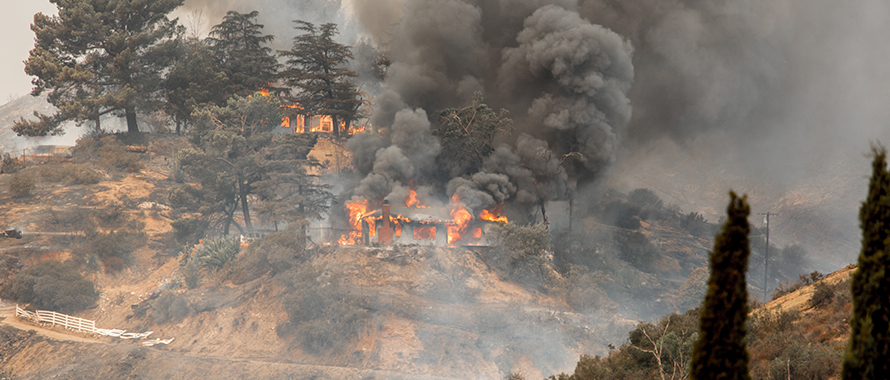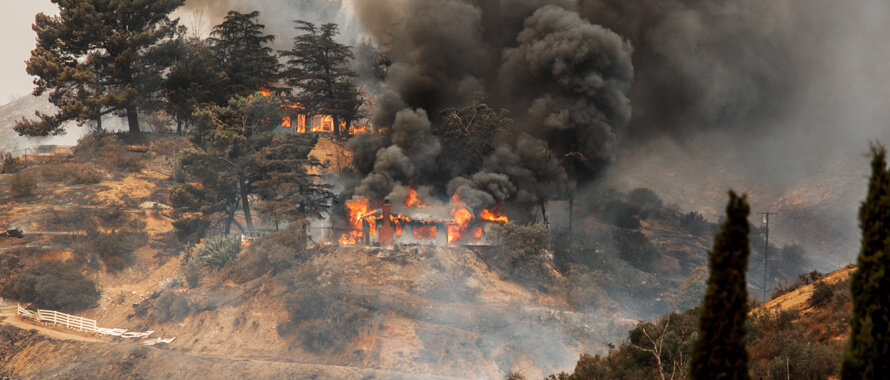
The impact of wildfires that raged across California the past two years will force one of the state’s largest utilities to file for bankruptcy protection later this month, but has also limited access to Homeowners Insurance policies statewide.
Pacific Gas & Electric Corp. (PG&E), found at fault for some 2017 wildfires, now faces additional liabilities that could exceed $30 billion for equipment failures that may have contributed to 2018 wildfires. While the greatest tragedy from the November 2018 wildfires is the loss of at least 85 lives, economic fallout has reached the insurance market. New regulations are being considered as the state comes to grips with who pays for the damage.
Statewide, residents filed billions of dollars of insurance claims in the wake of the 2017 wildfires, and by last year many had been told they would see their Homeowners premiums either increase or not renew, especially those with coverage for one of the reported 1.7 million homes in California considered “highly prone to wildfire.” Cancellation notices were sent to homeowners throughout last year and are expected to continue in 2019, according to industry experts.
“We’ve seen a big increase in wildfires for the past three to four years in California, so there are parts of the state where standard carriers are not renewing (policies),” said Tom Carvalho, Underwriting Manager, Personal Insurance, Burns & Wilcox, San Francisco, California. “Any carrier who wrote a Homeowners Policy in these areas has taken on losses because the fires have been so severe and spread out across the entire state.”
“Any carrier who wrote a Homeowners policy in these areas has taken on losses.” – Tom Carvalho, Burns & Wilcox
A California state ordinance limits the percentage of policy rate hikes, California Insurance Commissioner Dave Jones told CNBC in November 2018. This can confuse homeowners since the ordinance only covers standard policies, where rates are regulated by the state. Carriers in the excess and surplus markets, which generally write policies for higher risk properties, are not beholden to rate regulations, said Rich Gobler, Corporate Vice President and Managing Director, Burns & Wilcox, San Francisco, California.
“You have situations where standard policies are not available to some homeowners because of the (wildfire) risk so they have to go to the excess and surplus market where premium costs will be higher,” Gobler said. “They may see their Homeowners policy go from $1,500 to over $6,000 or more in one year. That becomes a major purchase decision when you consider buying a property, especially for a second home or a place in the woods. You might not be able to afford your mortgage.”
California residents can purchase a range of Personal and Commercial Insurance policies, including Homeowners, through the California FAIR Plan Association, which is composed of insurers authorized to transact basic property insurance in the state, provided guidelines are met. Policies available through the FAIR Plan are considered “last resort” but an estimated 15,000 homes in high- or medium-risk fire areas have purchased Homeowners Insurance through the FAIR Plan since 2014.
Recent wildfires have cost the state billions
The economic impact of recent wildfires has been extensive. By the end of last November, 52,000 wildfires burned 8.5 million acres across the U.S. More than 10 million acres from an estimated 71,500 wildfires burned in 2017 around the country. The “Wine Country” fires in California in 2017 alone led to $10.4 billion in insurance claims.
Early estimates pegged the total economic impact of the latest California wildfires to exceed $400 billion, making it perhaps the most expensive natural disaster in U.S. history, according to AccuWeather, which compares the expense to 2 percent of the country’s GDP. Yet the damage is greater than lost jobs, wages, buildings and other materials. There are health issues related to smoke inhalation that could cause respiratory problems for residents that may take years to manifest.
Wildfires cause much of the state’s real estate market to be soft
Another trickle-down effect is on the real estate market in California. Home sales in the most heavily impacted areas of a wildfire are “quite soft,” according to Oscar Wei, senior economist, California Association of Realtors.
Year-over-year home sales volume in California has slightly increased from 2015-2018 even though sales are at lower levels compared to a decade ago. Total sales volume-year-to-date as of November 2018 was 3 percent lower than 2017, a year in which there were nearly 462,000 total homes sold in the state. That number is 39 percent below the peak sales volume year of 2005, according to DataQuick, which is now a part of CoreLogic.
The real estate market’s recovery in areas impacted by wildfires could take six to 12 months to begin in earnest but it could be even longer before homeowners move back in, Wei said. Sales will likely be lower in communities directly affected by the wildfires, but could be higher in surrounding neighborhoods. The impact of higher interest rates and the economy would have a greater impact on the sales as a whole than recent wildfire history, Wei said.
Home prices and average rents increased as demand rose and supply decreased in areas around the 2017 wildfires Wei said, and he expects the same is true now for communities impacted by wildfires last year. Many residents who lost their homes might not be able to afford a new home purchase until their insurance payments are received, which given the scope of these wildfires could take months, Wei said.
“In our experience insurance premiums will definitely increase in the affected areas,” Wei said. Although he has not heard of homeowners being denied insurance specifically, Wei said that the housing and insurance markets in these communities will be “unsettled for a while.”
Newly constructed homes better protected, but insurance still hard to secure
The impact on new home construction in California has been minimal at best, said Dan Dunmoyer, president and CEO, California Builders Industry Association (CBIA). Dunmoyer, also experienced in the insurance field, said buyers of newly-constructed homes have been able to get escrows or purchase Homeowners policies, but polices are limited in some areas.
“We have seen a tightening of the insurance market with higher costs for new homes. But you are generally able to find options even if they are expensive,” Dunmoyer said.
New homes in California must meet modern, state-mandated fire prevention requirements like using Class A roofs and indoor sprinkler systems. Clearing trees and brush before construction begins is common.
“New homes are much more attractive from an underwriting perspective, so unless you see a situation where carriers prohibit insurance for all homes in an area, you likely will have (standard insurance) options,” Dunmoyer said. Those homeowners without those options will have to consider more pricey excess and surplus market policies or a FAIR Plan policy which Dunmoyer said is “lower quality.”
In 2017 there were more than 115,000 new home permits filed in California, according to the CBIA. Last year’s final numbers are expected by the end of January, but Dunmoyer estimates roughly 120,000 permits were filed in 2018.
Expect the insurance market to remain tight in the foreseeable future
“Insurance carriers had so many losses that it’s going to take more than three or four years of low or no wildfires to bring rates down.” – Rich Gobler, Burns & Wilcox
The increase in wildfires has caused many carriers to view California as a “catastrophic” insurance state, much like Florida, Louisiana or other states that have experienced heavy losses from hurricanes over the past two decades, Gobler said.
“Insurance carriers had so many losses that it’s going to take more than three or four years of low or no wildfires to bring rates down,” Gobler said. The wildfires haven’t been selective either, impacting communities from Malibu, Santa Ana and Santa Barbara in the southern part of the state to Sonoma and Paradise in the north—all of which have different demographics and topography.
That’s why it’s important for consumers looking to buy or sell a home, or anyone pricing insurance in California, to contact an insurance broker or agent to learn about their options, Carvalho said.
He suggests using an insurance broker as an advisor and to consider higher deductibles as a way to save money on Homeowners policy premiums. Carvalho also notes that one or more claims for even a few hundred dollars may force some carriers to cancel, so homeowners should delay or avoid making small claims.
“Don’t assume anything is certain with (a Homeowners policy in) California,” Carvalho said. “Often when you’re buying or selling a home, your insurance is an afterthought. That’s not the case here.”
As with any coverage need, an insurance broker or agent must be consulted. Click here to forward this article to your insurance broker or agent to ask if you need this coverage, or share this with clients to start the conversation and ensure proper protection.
This information was provided by Burns & Wilcox North America’s leading wholesale insurance broker and underwriting manager. Burns & Wilcox works exclusively with retail insurance brokers and agents to assist clients like you with their specialty insurance needs. Ask your insurance broker or agent about Homeowners policies for primary or secondary residences that might be right for you.
